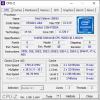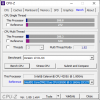Sorry, this was a thread intending to be a mini-review, but got kind of half-baked.
I agree with you, on modern workloads, this laptop probably is comparable, or better than, with the reasonably-decent including Intel iGPU, on desktop tasks, than a Core2Duo would be.
Did you catch the CPU-Z picture, where it identifies the 4205U CPU as a 3865U? I don't know of any surer indication that it is just a re-badge, when combined with the two basically-identical ARK pages on Intel's site.
Everybody bags on AMD and NVidia for re-badging, it's about time Intel caught some flak for it too, I guess.
I mean, it's not a horrible chip, even if it is basically re-warmed-over Kaby Lake. Though, I would have preferred a 2C/4T CPU, but that was an additional $70, with the price of this unit being $200 (+tax), that seemed to be too big of a bite for such a level of performance gain. Then again, I debated, if it extended the useful longevity of the laptop out a year or two more before it became "too slow to use", then it would probably have been worth it.
It's often foolish to buy laptops or other non-directly-user-upgradable PCs, too close to "the edge of obsolescence", as once it steps over the boundry, it becomes worth much, much less, and becomes basically a form of e-waste. This may be one of those cases, as it was pinned on the CPU doing Windows Updates, and they took nearly an hour to get up-to-date (even with SSD!), and then another two hours to download and install 1903 (on a FIOS Gigabit internet connection, though over wireless, which was giving me around 200Mbit/sec last night on speedtest.net ).
Just web browsing, it's OK, and gets nearly 6-7 hours of battery life connected to a 5Ghz AC AP. It can also Skype and web browse at the same time, but after accumulating a couple of dozen (maybe less) tabs, and being on Skype, I was using maybe 60% CPU time.
Which is a darn lot better than the 80-90-100% CPU time that my dual-core Atom N2830 laptops give me when I'm on Skype and trying to browse the internet.
My Ryzen 3 3200U laptop (which I upgraded to 2x8GB DDR4-2400 RAM), gives me around 30% CPU time while doing the same thing, and better battery life.
Intel is notorious for gimping Celeron's power-management features, reducing it's battery-life unnecessarily, for the sake of product positioning and profit margins. If there's anything that the "Green" folks should be up in arms about, it's not plastic straws, plastic bags, or anything like that, it should be that Intel is basically taking profits on the backs of unnecessary carbon emissions, from wasted power, because people didn't pay them enough, to "enable" the power-saving features that are physically present in all of their mfg'ed chips.
Could you imagine, that due to assembly-line efficiencies, all cars produced from one mfg, came with catalytic converters, but only the top-end cars sold, had them enabled? That their lower-end cars, had them "bypassed" and present but non-functional? That's basically what Intel is doing, crazy as it sounds from an ecological perspective.
Edit: Perhaps my rant is slightly mis-placed.
Enhanced Intel SpeedStep® Technology Yes
The 4205U does support "Enhanced" SpeedStep, as well as "SpeedShift".
Perhaps I was thinking of a prior era, in which Intel's Celeron CPUs, even their mobile CPUs DID NOT support "SpeedStep", and could not reduce their voltage and clocks for power-saving, while not under load, thus giving them much poorer battery life compared to more expensive laptops. However, this still seems to be true, for some reason, at least, for their "big-Core" CPUs, as opposed to their Atom lineup, which has excellent battery life.
Still doesn't support Turbo, which, based on the current best-practices of "Race to Idle", still is a lack of a power-saving feature, in terms of watts per task expended.
It should be noted that AMD does NOT disable Cool'N'Quiet or Turbo on any of their (modern) CPU lineup, and in fact, with Ryzen 3000-series CPUs and PB2, they optimize the performance of their CPUs dynamically for power/performance, quite well.





